
|
|

|
Hokusai - Ehon Sumida Gawa - Prints 3-4 and 3-5

|
|

|
The momiji (紅葉, also pronounced as kōyō, and translating into both “red autumn leaves” and “maple tree”) in the title of these two prints refers to the red leaves of the maple tree visible in print 3-4.
In the foreground we see Shōden shrine (聖天, which literally translates into “holy heaven shrine”) located on top of Matsuchiyama hill (待乳山, which translates into “waiting for breast hill”), both located just south of the San’yabori canal (三谷堀) and Imado bridge (今戸橋) crossing the mouth of this canal. The earth of Matsuchiyama hill was used for the elevation of Nihon dike (日本堤 which is pronounced as Nihonzutsumi), the embankment leading up to the licensed pleasure quarters of the Yoshiwara.
Being located so close to the Yoshiwara pleasure quarters, it does not come as a surprise that this place is rich in sexual connotation. The Shōden shrine is dedicated to an Indian god represented in an entwined conjugal embrace, and features as a distinctive symbol the long white radish called daikon - often in a curious form in which two split roots “embrace” each other.
Here is a nice winter scene showing Matsuchiyama hill, Shōden shrine, and Imado bridge as seen from the Sumida river (click to enlarge):
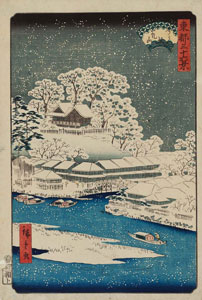
|
Imado Bridge and Matsuchiyama hill |
and this is a beautiful full moon night view of Imado bridge as seen from the north bank of the San’yabori canal:
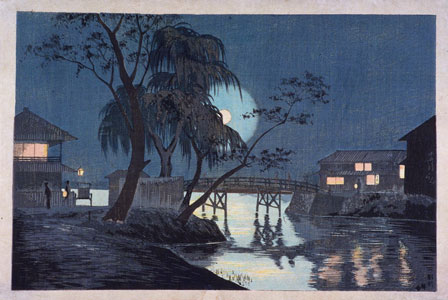
|
Moonlight on the Tea Houses at Imado Bridge |
More prints showing a view of Matsuchiyama hill and Imado bridge as seen from the east bank of the Sumida river are on my other website here, here, here, here and here.
The main hall of the Matsuchiyama Shōden shrine was destroyed in the 1923 Great Kantō Earthquake, and again in the bombing of Tokyo in 1945, but it was rebuilt in 1961. These are three photos I made at Matsuchiyama Shōden shrine in 2017 as well as the stamps and calligraphy I obtained from a priest in my goshuinchō temple stamp book (click to enlarge):
.jpg)
|
.jpg)
|
.jpg)
|
| Matsuchiyama Shōden shrine today (1) | Matsuchiyama Shōden shrine today (2) | A priest replenishing the daikon that visitors can buy and offer at Matsuchiyama Shōden shrine |
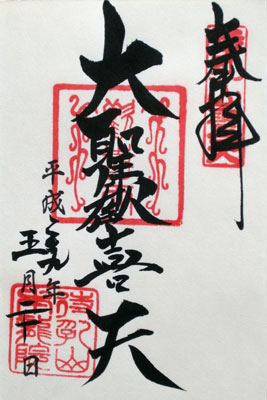
|
| Stamps and calligraphy in my goshuinchō temple stamp book |
The kanji in the calligraphy in the left column of the page in my goshuinchō are 平成二十九年五月二十日. This translates into Heisei 29, the 5th month, the 20th day, and thus in 2017, May 20 which is the date of my visit to the shrine.
These are two images of the just mentioned curiously formed daikon at the current shrine:
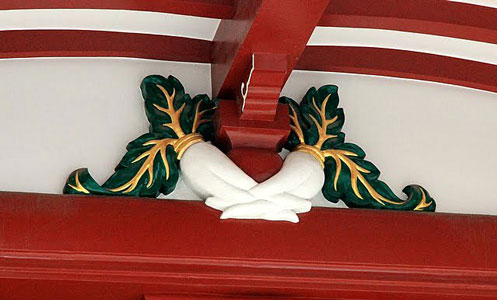
|

|
Rather than following the Nihonzutsumi embankment leading up to the Yoshiwara - the shortest route to the final view in his Ehon Sumida Gawa books, in his next prints Hokusai decides to make a detour through the villages or districts of Imado, Hashiba, and San’ya, all located on the west bank of the Sumida river.
The short route leading up from Matsuchiyama hill to the Yoshiwara is displayed in Utagawa Hiroshige’s 1857 print “Nihon embankment, Yoshiwara” (click to enlarge):
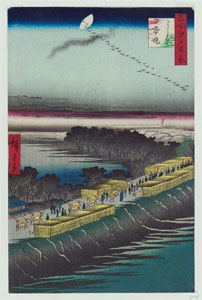
|
Nihon embankment, Yoshiwara |
Having arrived at Imado bridge, this is the route that visitors of the Yoshiwara pleasure quarters would normally have taken. Some visitors - with a desire of total anonimity - would have hired a palanquin for the entire journey. Others would have rented a chokibune river taxi from one of the boat houses at Shin Yanagi bridge and disembarked at Imado bridge. Still others would have walked all the way from wherever they lived in Edo.
Even on this last stretch there were several options. Visitors could rent a palanquin, as four have done in this print, or they could continue on foot, concealing their face with a dark hood. Along the Nihon embankment there were more than a hundred teahouses, each bearing a red lantern with the mark of a particular brothel to which prospective customers would be introduced. However, most visitors of the Yoshiwara would have made advance arrangements at one of the teahouses or boathouses along the way to Imado bridge.